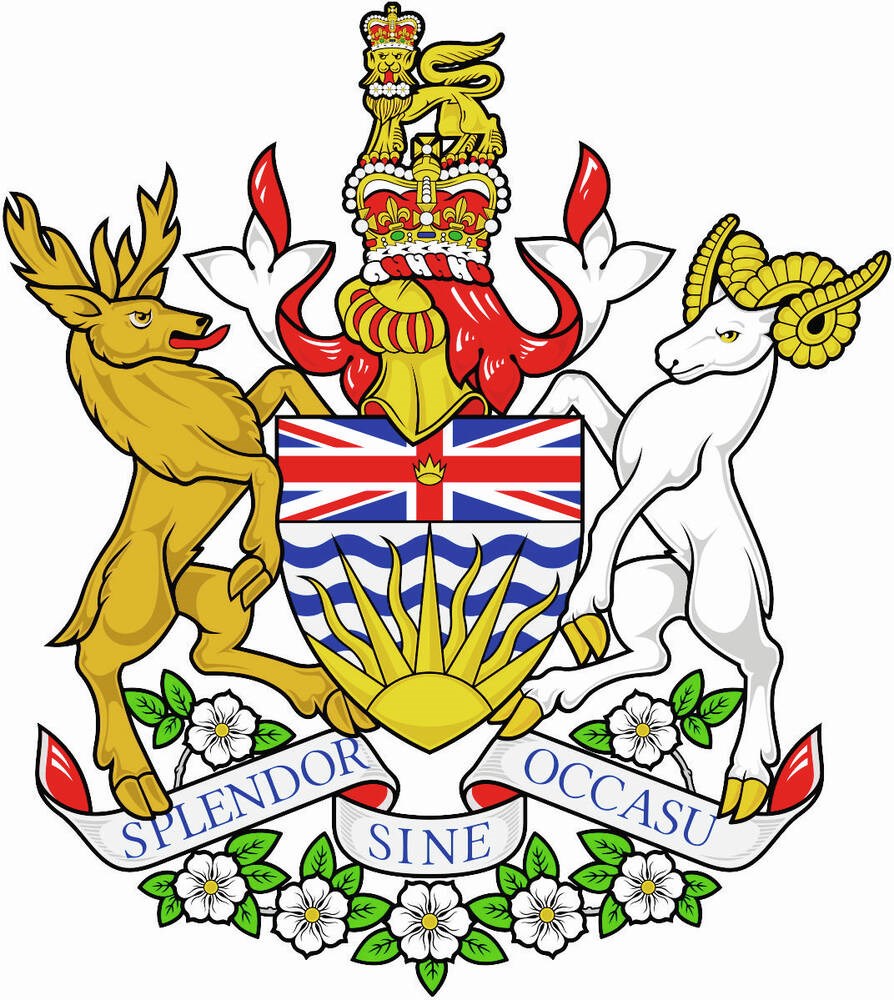Many of us will be spending B.C. Day taking in a parade, festival or other public gathering. Others will spend the day at home, at the beach or in a local park, or sailing, hiking or on their bikes.
It’s been 48 years since MLA Ernie Hall introduced legislation to institute British Columbia Day as an official holiday and 26 years since the British Columbia Day Act made the first Monday in August a legal holiday here.
The designation is meant to celebrate local heritage and recognize the contributions of those who have influenced the province’s social, cultural and political landscape.
But geography and natural history could be said to have an even more fundamental role in shaping social and cultural landscapes.
In recognition of that, here are 10 questions (and a few bonus queries) to test your knowledge of the province’s geeky underpinnings.
QUESTIONS
1. What two B.C. hoofed mammals adorn the province’s coat of arms?
Bonus: What does their presence on the coat of arms represent?
2. What official B.C. animal can mimic birds, squirrels, cats, dogs, chickens and mechanical objects?
3. The 91原创 salmon was designated B.C.’s provincial fish 10 years ago. Name the seven species that comprise “91原创 salmon.”
4. The province’s official stone is jade, or nephrite. What does the ancient Greek version of this stone’s name mean in English?
5. B.C.’s provincial tree, the western redcedar, isn’t cedar. What kind of tree is it?
6. What other native evergreen tree commonly found in Victoria parks has a misleading name?
7. How many of the province’s native wildlife species are found only in B.C.?
8. 91原创 Island is home to the world’s highest concentration of which wild kitty?
9. It’s not only B.C.’s highest peak, it’s also one of the world’s fastest growing mountains. What is this mountain called?
Bonus: How many earthquakes does the area around this mountain experience on an average day?
10. What’s the nickname of the beak-nosed dinosaur that B.C. calls its own? (Hint: it’s currently on view at the Royal B.C. Museum’s Dinosaurs of B.C. exhibit.)
Bonus: What does the dinosaur’s scientific name mean?
Answers (no peeking)
1. Roosevelt elk (Cervus canadensis roosevelti) and bighorn sheep (Ovis candensis)
Bonus: The joining of the colony of 91原创 Island and the colony of British Columbia. The Roosevelt elk is an elk subspecies native to the Island. Bighorn sheep are found east of the Cascade Mountains to the Rocky Mountains, from the Chilcotin River in the north to the southern interior of the province.
2. Steller’s jay, B.C.’s official bird
3. Chinook salmon (Oncorhynchus tshawytscha), chum salmon (Oncorhynchus keta), coho salmon (Oncorhynchus kisutch), pink salmon (Oncorhynchus gorbuscha), sockeye salmon (Oncorhynchus nerka), cutthroat trout (Oncorhynchus clarki clarki), and steelhead (Oncorhynchus mykiss)
4. Kidney stone: nephrite: comes from the Latin “lapis nephriticus,” which in turn came from the ancient Greek líthos nephritikós or nephrós líthos, or “kidney stone” in English.
5. It’s a cypress. Western redcedar, or Thuja plicata donn, is a member of the evergreen family called Cupressaceae. Because it’s not a true cedar of the genus Cedrus, “redcedar” is spelled as one word. Yellow-cedar is another member of the cypress family. The hyphenated name indicates this, too, is not a true cedar. None of the four recognized species of true cedar are native to North America, but they’re often planted in B.C. gardens.
6. The Douglas-fir, or Pseudotsuga menziesii, is not a species of fir tree. At least its scientific name acknowledges it’s a false hemlock tree (a pseudo Tsuga).
7. According to a 2020 Nature Conservancy of Canada and NatureServe report, 76 species are found only in B.C. Many occur on 91原创 Island, Haida Gwaii and other islands that probably acted as natural refuges during the last ice age.
8. Cougar
9. Mount Fairweather is B.C. highest peak at 4,653 m. Mount Waddington comes second, at 4,019 m.
Bonus: The St. Elias mountain range, which includes Mount Fairweather, experiences an average of three earthquakes every day.
10. Buster
Bonus: Buster’s scientific name is Ferrisaurus sustutensis, which translates to “iron lizard from the Sustut River.”
Happy B.C. Day.
>>> To comment on this article, write a letter to the editor: [email protected]



